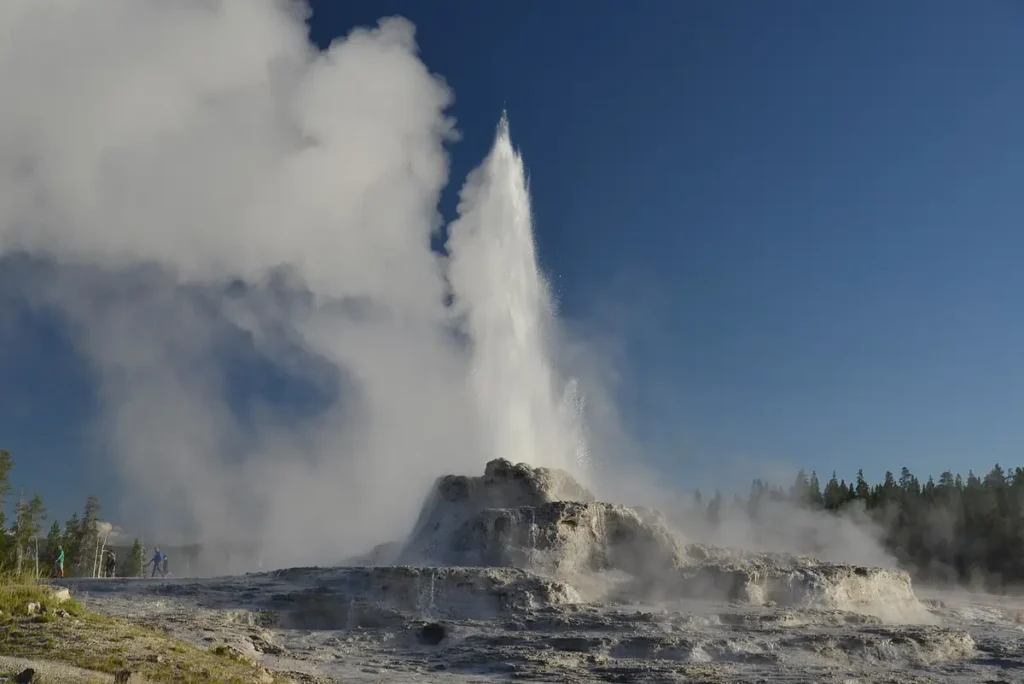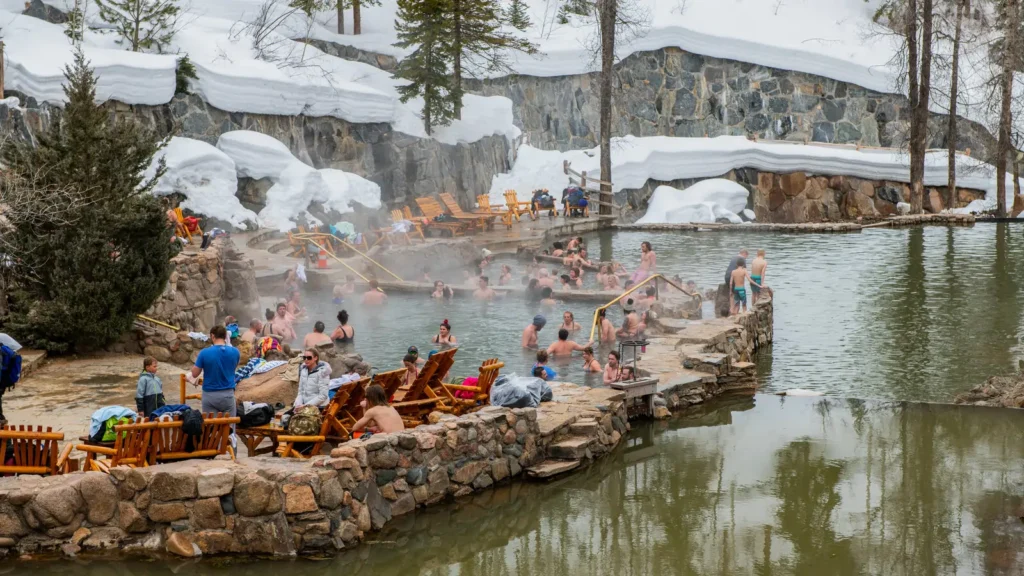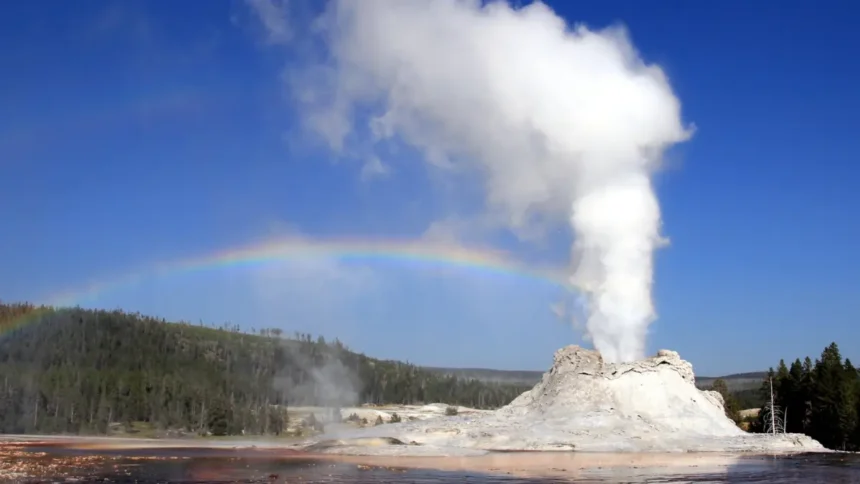Introduction
Have you ever marveled at the sight of a geyser erupting, sending towering jets of water and steam into the air? Yellowstone’s famous Old Faithful is perhaps the most iconic example, but geysers can be found in various geothermal hotspots worldwide. But what exactly causes these dramatic eruptions? Why do some geysers erupt regularly while others remain dormant for years?
In this article, we’ll explore the science behind geyser eruptions and the unique conditions that allow these natural wonders to exist. Whether you’re a curious traveler planning a trip to Yellowstone or just someone fascinated by geology, understanding the mechanics of geysers will give you a newfound appreciation for these incredible forces of nature.
Read also: Yellowstone National Park: 5 Must-See Geothermal Wonders in Yellowstone National Park
What is a Geyser?
Overview: A geyser is a rare hot spring that periodically erupts, ejecting water and steam into the air. Unlike ordinary hot springs, which bubble gently, geysers are defined by their explosive activity.
- Key Fact: Geysers are rare. Only about 1,000 active geysers are worldwide, most located in Yellowstone National Park.
- Fun Fact: “geyser” comes from the Icelandic word geysa, meaning “to gush.”
Why They Matter: Geysers are not just visually spectacular; they provide critical insights into the geothermal activity beneath the Earth’s surface, acting as natural pressure valves for underground heat and water.
The Science Behind Geyser Eruptions
Overview: So, what exactly causes a geyser to erupt? The answer lies in combining geothermal heat, water, and a unique plumbing system beneath the Earth’s surface. Let’s break down each component:
- Heat Source: Geysers are located in geothermal regions, where magma lies near the Earth’s surface. This underground magma heats water trapped in the Earth’s crust.
- Water: Rain or snow water seeps into the ground and collects in underground reservoirs. When the magma heats this water, it rises back toward the surface.
- Plumbing System: Unlike regular hot springs, geysers have a narrow underground channel or plumbing system that traps and pressurizes the water. As the water is heated, the pressure builds until it forces the water and steam to burst through the surface in an explosive eruption.
Read also: Unlocking the Truth: Is Geothermal Energy the Ultimate Renewable Resource?
Why Geysers Erupt: When the water in a geyser’s reservoir reaches boiling point under high pressure, the resulting steam forces the water above it to shoot into the air. This process repeats itself, leading to periodic eruptions.

How Different Factors Influence Geyser Eruptions
Overview: Several factors influence how often a geyser erupts: height and duration. Let’s explore the main ones:
- Water Supply: Water availability from rainfall or snowmelt directly affects how much water a geyser can heat and expel. More water often leads to more frequent eruptions.
- Heat Intensity: The temperature of the geothermal heat source plays a key role. Higher temperatures create more steam, resulting in more powerful eruptions.
- Plumbing Structure: The geyser’s underground channels’ shape, length, and width also impact its behavior. Due to pressure buildup, narrower channels lead to more intense eruptions.
- Mineral Deposits: Over time, minerals in the water can form silica deposits around a geyser’s vent, altering the eruption patterns by blocking or reshaping the plumbing system.
Interesting Fact: Old Faithful erupts every 90 minutes, but its exact interval varies depending on the amount of water and heat available at any given time.
Read also: Volcanoes – The Science And Secrets Of The Mountains Of Fire
Famous Geysers Around the World
Geysers are rare; only a few locations worldwide are home to these geological marvels. Let’s take a look at some of the most famous ones:
| Geyser Name | Location | Height of Eruptions | Frequency of Eruptions |
| Old Faithful | Yellowstone National Park, USA | Up to 185 feet | Every 60-90 minutes |
| Strokkur | Iceland | Up to 130 feet | Every 6-10 minutes |
| Pohutu Geyser | Rotorua, New Zealand | Up to 100 feet | Up to 20 times per day |
| Lady Knox Geyser | Wai-O-Tapu, New Zealand | Up to 65 feet | Erupts daily with intervention |
Why It’s Fascinating: Each geyser has its unique eruption pattern, influenced by the local geothermal activity and the specific conditions of its underground reservoir. For example, Strokkur in Iceland erupts more frequently than Old Faithful due to its shallower and more direct underground channels.
Read also: Land of Contradiction – Why is Iceland volcanically so active?
Geysers vs. Hot Springs: What’s the Difference?
Overview: Although geysers and hot springs both involve hot water from beneath the Earth’s surface, their behaviors are quite different. Understanding the differences can help explain why only certain hot springs erupt.
- Hot Springs: A hot spring is a pool of water heated by geothermal activity that rises gently to the surface without erupting. These are common in geothermal regions and are known for their calm, consistent flow.
- Geysers: Unlike hot springs, geysers have a pressurized underground system that periodically forces water and steam into the air.

Why They’re Different: The key difference is the plumbing system. Geysers have narrow, constricted passages that trap steam and create enough pressure to cause an eruption, while hot springs have open, unobstructed channels that allow water to flow smoothly.
Read also: Don’t Miss These 5 Hidden Hot Springs: Your Secret to Ultimate Relaxation
The Dangers of Geysers
Overview: While geysers are incredible natural wonders, they can also be dangerous. The water they eject is often near boiling point, and the force of the eruptions can cause serious injury if visitors get too close.
- Key Fact: The water temperature in geysers can reach over 200°F (93°C), hot enough to cause severe burns.
- Visitor Safety: Yellowstone National Park has experienced multiple incidents where tourists were injured after stepping off designated walkways near geysers.
Safety Tip: Always stay on marked paths and boardwalks, especially around geyser basins. The ground surrounding the geysers is fragile, and the water below is dangerous.
Conclusion:
Geysers are one of the Earth’s most dramatic and fascinating natural phenomena. They occur due to the combination of geothermal heat, water, and a unique plumbing system beneath the surface that traps and pressurizes the water until it erupts. Each geyser has its eruption pattern, influenced by factors such as water supply, heat intensity, and the structure of the underground channels. By understanding the science behind geysers, we can better appreciate these rare and powerful natural wonders.
FAQs:
1. What causes a geyser to erupt?
Geysers erupt when underground water, heated by geothermal activity, becomes steam. The steam builds pressure in the geyser’s narrow plumbing system, forcing water and steam to shoot into the air.
2. How often do geysers erupt?
The eruption frequency varies by geyser. For example, Old Faithful erupts every 60-90 minutes, while others, like Strokkur in Iceland, erupt more frequently.
3. Why are geysers rare?
Geysers require a unique combination of geothermal heat, water, and a specific plumbing system. Because these conditions are rare, only about 1,000 active geysers are worldwide.
4. What’s the difference between a hot spring and a geyser?
A hot spring releases heated water gently without erupting, while a geyser has a pressurized system that causes it to erupt forcefully.
5. Can geysers be dangerous?
Yes, geysers can be dangerous due to the water’s extreme heat and the force of eruptions. Visitors should always stay on designated paths to avoid injury.





